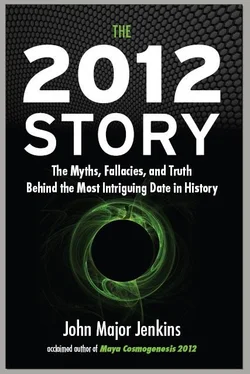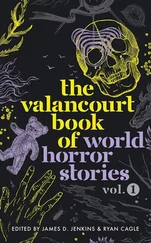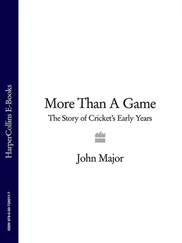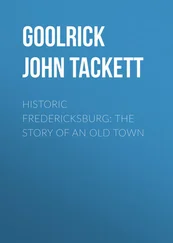And so The Popol Vuh (Book of Council, Book of the Dawn of Life) was copied for posterity and translated into Spanish. Father Ximénez, an accomplished linguistic and student of Mayan grammar, was well suited to the task. The original manuscript that he worked from was written in the 1550s. Some scholars believe that the Maya elders who did it were drawing from an older hieroglyphic book. 6Certain mythological scenes and deities found in The Popol Vuh are also portrayed on ancient carved monuments at early Maya sites dating back more than 2,100 years, suggesting that an ideological gold mine of great antiquity was preserved in the ancient text.
But metaphorical gold is not real gold. As so often happened with the treatment of native wisdom, Ximénez’s offering to the outside world slipped into the shadows and was not published until 1857. By then, intrepid explorers had already delved into the jungles of Central America and were finding evidence of a forgotten civilization—people who, a thousand years prior to Ximénez, were painting the stories of The Popol Vuh on vases and in their books. In those pages the gods and planets danced to the tune of the sacred 260-day calendar, a system of divination and timekeeping that survives today in the remote villages of Guatemala. But not all areas inhabited by the Maya have retained this continuity of the ancient calendar traditions.
During the conquest of the Maya in the Yucatán, the 260-day calendar was still being followed. Franciscan friars were streaming off the boats, arriving armed with the mandate of the Catholic auto-da-fé, the jihadlike Inquisition, their heads loaded with deep prejudices against pagans who were ignorant of the One Holy Faith. Bishop Diego de Landa was one of these early evangelicals, hell-bent on converting the heathens. His intent was to curtail idolatrous devil worship, and the result was the destruction of native genius.
De Landa’s book burning in the Yucatec Maya village of Mani in 1562 largely succeeded in this endeavor of unbridled zealotry. Hundreds of Maya books were heaped in piles and destroyed. Today, only four known examples survive: the Dresden, Madrid, Paris, and Grolier codices. In time, the native calendars in Yucatán were likewise stamped out. This kind of act was nothing new for Christianity, whose champion Emperor Theodosius likewise ordered “pagan” temples destroyed in 391 AD, including the Alexandrian Museum and the Serapeum that housed major parts of the Alexandrian library. The dearth of direct evidence about what the ancient Maya knew and believed has caused prejudices and misconceptions to multiply. An embedded bias within Western assumptions, installed by both religious and scientific training, that the Maya were unscientific has continued to today and often prevents a clear assessment of Maya culture on its own terms.
The case of de Landa contains within it one redeeming component, for he was also responsible for recording and preserving information about the dates and glyphs of the Maya calendar. In an act of curiosity that, for once, outweighed his disgust, he compiled information from various Maya informants and attempted to interpret the day-signs of the calendar, believing they were phonetic letters of the Maya alphabet. Although de Landa was far off base, his Relación de las Cosas de Yucatán preserved important facets of Maya writing and language. His book, rediscovered and published three centuries later by French cleric Brasseur de Bourbourg, became the key with which early scholars of the Maya were able to begin reconstructing knowledge that had been lost, such as the workings of the Maya calendar and the enigmatic hieroglyphic writing system.
During the sixteenth century a theological debate was raging among the Franciscans—did the Maya have souls? Why even try to spread the Christian faith to soulless, irreversibly damned heathens? Can animals enter the kingdom of heaven? These debates were typical in the mid-1500s, revealing popular attitudes and the formulation of official church policy. Today, despite progress in allowing indigenous Americans to have souls, prejudices remain deeply rooted. One way out of the mire of prejudice that emerged in the 1800s was to see them as noble savages. Charles Darwin was both an evolutionist who saw naked savages as repugnant and a stalwart abolitionist, a paradoxical stance that explains contradictory attitudes toward natives in his famous book The Descent of Man . On one hand he saw them as gentle and kind, peace-loving tribes. On the other, they were naked, disgusting, and unintelligible. Nevertheless, a romanticized portrait of natives appealed to the European imagination. It countered negative attitudes, but the alienation between the “civilized” nations and the “uncivilized” heathens was sustained as the Maya remained objects of contemplation rather than fellow humans.
In the lowlands of the Lacandon rain forest, running west of the great Usumacinta River that divides Mexico from Guatemala, the last remnants of unconquered Maya have, technically, survived up into the twenty-first century. As recently as the 1960s anthropologists were studying the ancient beliefs, dreams, and ceremonies of the Lacandon. 7They still visited the ancient altar shrines of their long-dead ancestors, burning incense in “god pots” (ritual ceramic vessels) in the overgrown ruins of Bonampak. But the Lacandon were in the twilight phase of their cycle of existence, their numbers dwindling to less than a hundred, and therefore they fell prey to problems caused by inbreeding. Though they have been known for refusing to join the ways of the Europeans, the recent generation of this dwindling group of holdouts has now finally made the leap. They wear their characteristic flowing white tunics only when making appearances at the site of Palenque, or at the Na Bolon study center and museum in San Cristobal de las Casas. But back in the 1870s they were ghosts in the jungle, strange forest dwellers who ate monkeys and moved here and there between ceiba-shrouded encampments.
In a bizarre meeting that signaled the end of their jungle idyll, explorer Alfred Maudslay sought out the Lacandon Maya, the archetypal “other,” on his way to Yaxchilán in 1882. Punting down the Usumacinta River, his guides directed him to pull ashore. The path they took was marked in spots with jaguar skulls. Eventually they came to a clearing containing three huts, where a Lacandon woman came out to meet them. Maudslay wrote:
She had not the slightest trace of fear; she smiled quite happily and received us most courteously, asked us to go into a small open house and said that all the men were away hunting cacao … the woman had features exactly like the faces at Palenque and Menché, receding forehead, hooked nose, and big lips. She was quite pleasant and talkative…. 8
Stereotypes of the Lacandon as fierce jungle savages were not confirmed by Maudslay’s experience.
The Lacandon were only one leaf on the tree of Mesoamerican civilization. In fact, after the Conquest most of what was known and studied about the New World Indians came out of the remnants of the Aztec empire. The situation there as it unfolded through the centuries is fairly unique in the development of European and native interactions in the New World. As Carlos Fuentes said, “Mexicans descend from the Aztecs, while Argentinians descend from ships.” 9Blood mixture and intermarrying have made the Aztecs an essential ingredient of what a modern Mexican is. Today, many Lati nos and Chicanos proudly recognize their Aztec heritage. While “the other” was and still is rejected as a matter of course by many Americans (meaning denizens of all the Americas), the modern Mexicans have become the other .
In Central Mexico, far to the west of the Maya heartland, another friar, Bernardino de Sahagún, spoke with native informants and documented the beliefs of the children of Moctezuma. The sense of something profound in native traditions that should be preserved continued with other well intentioned Spaniards. Diego Durán compiled and preserved many documents on the native calendar and histories, and in the late 1500s he wrote The Book of the Gods and Rites of the Ancient Calendar. As usual, however, his work was suppressed and filed away in the archives and remained unpublished for almost three hundred years. 10
Читать дальше












